BIM Management
BIM management plays a crucial role in maximising the benefits of BIM technology throughout the entire construction process. It ensures that BIM is utilised efficiently, leading to improved project outcomes, reduced costs, enhanced collaboration, and better-informed decision-making.

BEP (BIM Execution Plan)
BEP stands for "BIM Execution Plan." A BIM Execution Plan is a comprehensive document that outlines the processes, procedures, and methodologies for the implementation of BIM on a construction project. It serves as a roadmap for how BIM will be used and managed throughout the entire project lifecycle, from design and construction to facility management. The BIM Execution Plan is typically developed during the early stages of a project and is a collaborative effort involving various stakeholders, including the client, design team, contractors, and BIM managers. The plan should be tailored to the specific requirements of the project and should align with the project's goals and objectives.

Clash Detection
In Building Information Modeling (BIM), clash detection is the technique of identifying if, where, or how two parts of the building (e.g., plumbing, walls, etc.) interfere with one another.

Building coordnation
There are several elements to consider in 3D BIM coordination, and one of the first places to start the process is with a 3D coordinated model. Integrating architectural, structural and MEP trades together into a coordinated 3D model is part of the 3D BIM (building information modelling) coordination process. The BIM process is an effective 3D modelling tool that helps generate precise, accurate 3D coordinated models during the design development of a construction project. With a fully coordinated BIM model, users can see just how the architectural, MEP and structural systems have been coordinated in a 3D environment, and making changes becomes easy.The process of 3D BIM coordination involves recording, using and reviewing detailed data about a building’s physical functions. The information can also be used to prepare task schedules in 4D, calculate project costs and material take-offs and optimise the sustainability of the overall business design. One way of looking at BIM coordination is to think of it as being a grouping together of 3 distinct functions, namely:
Actual physical construction (building)
Coordination of detailed data (information)
Coordination of an accurate 3D model (modelling)

